Mastering the Ollie: A Comprehensive Guide to Skateboarding
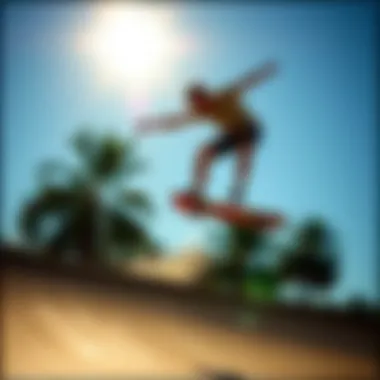
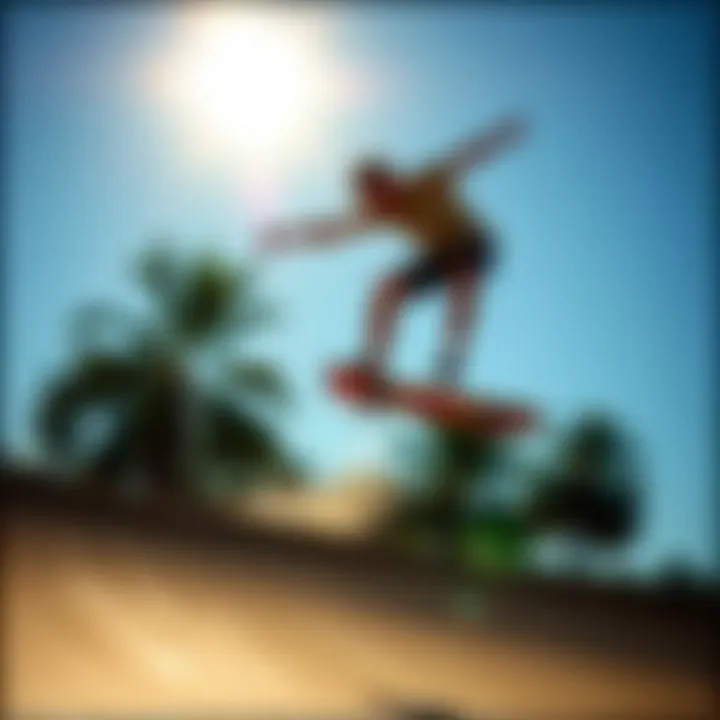
Intro
Skateboarding, often seen as a rebellious sport, has its roots deeply embedded in creativity and expression. Among the various tricks that skaters flaunt at parks or down urban streets, the ollie stands out as a fundamental move, a rite of passage for any skateboarder. It's not just a trick; rather, it's the gateway to a world of endless possibilities on a skateboard. This simple yet profound maneuver enables skaters to leap over obstacles and transition into more complex tricks, making it essential for mastering the art of skateboarding.
Learning the ollie is like laying the groundwork for making your own unique mark in the skateboarding world. While many may think it just involves hopping into the air, the truth is that it requires a solid understanding of your board, coordination, and timing. Over the following sections, we will explore the intricacies of the ollie, its historical backdrop, and tips that will help you refine your skills—whether you're a fresh face on the board or a seasoned rider looking to recapture the magic of your early days.
This guide fuses practical insights with a touch of nostalgia for those who have embraced the skateboarding culture. By the end of this journey, not only will you be equipped with the knowledge to perform an ollie, but you’ll also grasp its significance in the broader landscape of skateboarding.
Let’s kickstart your adventure by delving into the gear and equipment essential for every aspiring skater.
Understanding the Ollie
Grasping the essence of the ollie is pivotal for anyone serious about skateboarding. This trick, a seemingly simple leap into the air, is much more than just a flashy move. It forms the backbone of countless skateboarding maneuvers. Without mastering the ollie, skaters may find themselves hindered, unable to progress to more complex tricks.
The ollie is not only a physical challenge but also a mental one. It demands precise timing and positioning—two elements that can significantly impact performance. By understanding the ollie, skateboard enthusiasts, whether newbies or seasoned riders, can unlock a whole new world of possibilities. Learning its mechanics allows skaters to transfer their skills to advanced tricks that depend on it.
Defining the Ollie
So, what exactly is an ollie? At its core, the ollie is a skateboarding maneuver that allows the rider to elevate the board off the ground without grabbing it with their hands. The trick involves a combination of pop and drag. To perform it, the skater presses down on the tail of the skateboard while simultaneously dragging the back foot up towards the nose. The sudden pop off the tail takes the board into the air, while the drag keeps it aligned with the rider’s feet.
- Key components of the ollie:
- Pop: Sudden press on the tail
- Drag: Moving the foot up the board
- Lift: Elevating the board with feet positioning
Once these components are executed fluidly, the skater can achieve airtime, which opens the door to digital maneuvers like kickflips, heelflips, or even grinds.
Importance in Skateboarding
The significance of mastering the ollie in skateboarding cannot be overstated. It is not only a fundamental trick but also serves as a rite of passage for many skaters. Those who can perform a clean ollie often gain the confidence to tackle more daring tricks and challenges. Moreover, it broadens the spectrum of tricks available to the skater, enabling creativity and expression on the board.
- Benefits of mastering the ollie:
- Foundation for other tricks: Essential for progressing in skateboarding.
- Improved board control: Enhances overall riding skills.
- Builds confidence: Accomplishing this trick encourages further exploration of skateboarding.
It's no wonder that the ollie is often taught first. Get a grip on this trick and it’s as if you’ve got the keys to a treasure chest, unlocking various adventures that lie within the skateboarding community.
Mastering the ollie reads like a rite of passage in skate culture; it's not merely about doing a trick but establishing a foundation for everything that follows.
The History of the Ollie
The ollie, a fundamental trick in the world of skateboarding, carries with it a significant historical weight that not only shaped individual skateboarding styles but also the very culture surrounding the sport. This section aims to explore the roots of the ollie, shedding light on how it emerged and was integrated into the broader skateboarding scene. Understanding the history of this trick enriches one's appreciation for its technique and relevance today.
Origins of the Trick
The ollie traces its origins back to the late 1970s, a vibrant time for the burgeoning skateboarding community. A pivotal figure in the development of the ollie was Alan Gelfand, known as "Ollie" himself. In the early days, skaters relied heavily on ramp riding and vert techniques. Gelfand's innovation was to create a way to lift his skateboard off the ground without the use of ramps or additional height. By using a combination of foot placement and body movement, Gelfand executed a maneuver that allowed skaters to elevate their boards while maintaining control, essentially giving birth to the ollie.
The trick gained traction when other skaters recognized its potential. In no time, this simple yet revolutionary movement became a cornerstone technique that could be adapted into numerous other tricks, like grinds and flips. The fact that one could perform tricks without needing additional structures to skate on opened up a world of possibilities, pushing the boundaries of what skateboarding could be.
Influence on Skateboarding Culture
The impact of the ollie on skateboarding culture cannot be overstated. It did not just change how tricks were performed; it redefined the identity of skateboarding itself. Before the ollie, skateboarding was mostly seen within the confines of skate parks or specific locations designed for tricks. With the ollie, skaters began discovering new environments where they could express their skills. The street skating movement emerged, shifting the focus from ramps and pools to urban landscapes.
"The ollie transformed urban terrains into playgrounds, allowing skaters to assert their style on everything from curbs to sets of stairs."
This transition marked an essential evolution in skateboard culture, fostering community and paving the way for various styles. Additionally, the ollie helped to democratize the sport. Where before skateboarding might have felt exclusive to certain realms or locales, the ollie encouraged skaters of all backgrounds to find their space within the culture. With its rise, we also saw the emergence of skate videos that showcased street skating, thereby spreading the allure of skateboarding further.
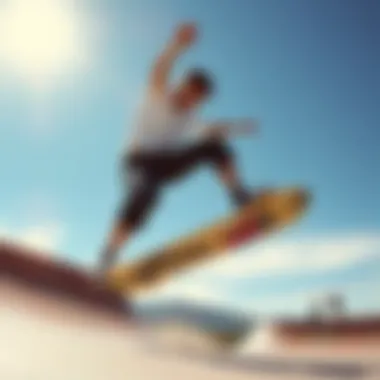
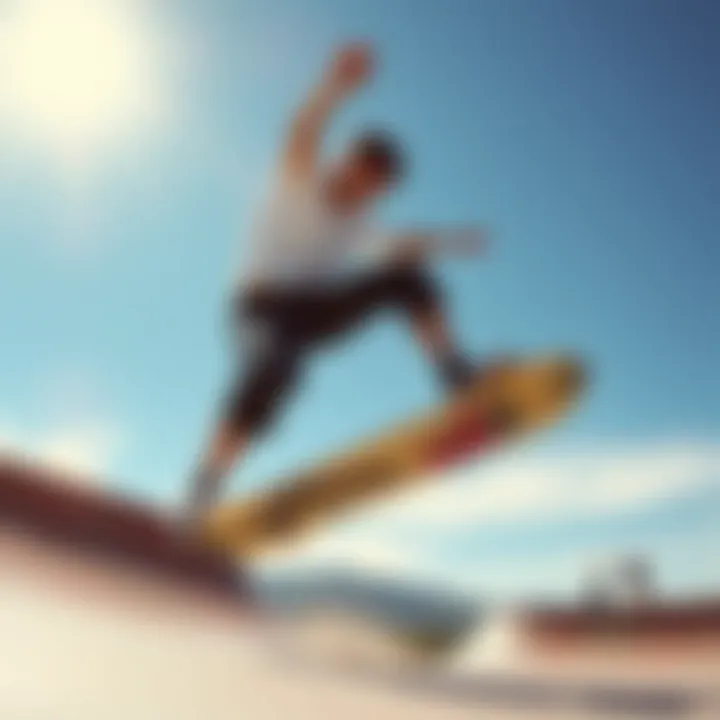
Essential Gear for Performing an Ollie
When it comes to nailing the ollie, the equipment you use can significantly affect your performance. The right gear not only makes the trick easier to execute but also keeps you safe while you practice. The combination of skateboard and footwear creates a synergy that enhances your ability to pop and land efficiently. Let's break down each component to understand why they matter.
Selecting the Right Skateboard
The skateboard itself is crucial. Not just any board will do. When choosing one for performing an ollie, consider the following factors:
- Deck Width: A wider board provides more stability, making it easier to land. Generally, a width between 7.5 to 8.25 inches is ideal for beginners. It allows you enough grip to control your feet.
- Concave Shape: A concave deck helps you lock your feet in place during the trick, giving your ollie that extra pop. Deeper concave is usually favored by street skaters.
- Material: Most skateboards are made from maple wood, but different materials like bamboo or composite boards are available as well. Maple is durable and offers a great return in terms of flexibility and strength.
- Wheels: Softer wheels (around 78A-87A durometer) provide a smoother ride outdoors while harder wheels (88A-101A) are better suited for tricks on solid surfaces.
Selecting the right skateboard tailored to your style can turn a daunting ollie into a more manageable feat.
Choosing Appropriate Footwear
Your shoes play an instrumental role in your ability to perform an ollie. They need to offer the right balance of grip, flexibility, and protection. Here’s what to look for:
- Flat Soles: Choose skate shoes with flat soles. This design allows you to feel the board directly under your feet, enhancing your control and sensitivity during the trick.
- Grip: Look for shoes with rubber outsoles that have a good amount of tread. This grip is vital for ensuring you don't slip off the board when you pop your ollie.
- Padding: While you want flexibility in your footwear, adequate padding around the ankle can provide protection during falls or missteps, which are part and parcel of learning.
- Breathability: Skateboarding can be physically demanding, and extra heat can lead to discomfort. Shoes made of breathable materials keep your feet cooler as you practice your moves.
Ultimately, having the right footwear means better connection with your skateboard. It’s all about finding that perfect balance that feels comfortable yet provides the necessary support.
In summary, investing in the right skateboard and shoes is not merely about comfort; it’s about increasing your potential to master the ollie. A few thoughtful selections can save you a lot of hassle down the road while also boosting your confidence.
For further reading on gear and safety, you can check resources such as Skateboarding.com and Skate Warehouse.
Technique Breakdown: Performing an Ollie
To truly grasp the art of the ollie, breaking down the technique into digestible parts is crucial. This not only clarifies the method but also highlights the essential skills needed to perform the trick successfully. The ollie is not merely about getting air; it's about how you can connect movement and rhythm. Mastery of this trick serves as a profound foundation for the more complicated maneuvers that follow. A solid grasp of technique will bolster confidence and increase safety during practice, making this section pivotal for any aspiring skater.
Stance and Positioning
Your stance is the bedrock on which the ollie is built. Positioning your feet properly can make or break your ability to pop and level out during the jump. Start by placing your back foot firmly on the tail of the board, giving it the leverage needed to initiate the ollie. Your front foot should rest across the skateboard's width, ideally around the middle part. This setup not only ensures control but also promotes better balance.
An important tip here is to keep your knees slightly bent. This posture allows for a quick load and unload of energy, preparing the skateboard for a more effective takeoff. Every seasoned skater will tell you, if the balance is off, the trick will falter. As you gain comfort, try shifting your weight from your back foot to your front foot during practice.
Timing and Coordination
Timing can seem like an instinctive skill, but in reality, it's refined with practice. The perfect ollie combines the simultaneous action of popping the tail and dragging your front foot upward. This sequence turns a basic jump into a smooth, controlled ollie. To get the timing right, begin to visualize your movements as a rhythm—almost like dancing with your board.
Coordination is key here. You won't just jump straight up; rather, you need to master the connection between your feet and the board. Start by performing small hop drills while focusing solely on coordination. This can reinforce how to maintain the relationship between foot action and board movement, making the full ollie feel more natural over time.
The Takeoff
The takeaway phase is perhaps the most thrilling part of the ollie. As you gather energy from your bent knees, push down hard on the tail of the skateboard. This downward force should propel you upward as your front foot drags along the grip tape, pulling the board up with you. Remember, the tail's contact with the ground is what creates the pop, so hitting it with precision is key.
As you takeoff, aim to keep your body centered over the board. Leaning too far forward or backward can lead to a rough landing or a wipeout. Focus on driving your knees upward while maintaining a tight core for stability.
Landing Techniques
Landing an ollie can be just as intricate as taking off. The goal is to absorb the impact while keeping the board under you. Begin by looking at your landing spot long before you descend. This forward gaze not only helps with balance but keeps you mentally prepared. As the board descends, bend your knees once more to cushion the fall—much like a cat landing on its feet.
Your feet should naturally land with the bolts or slightly over them. This positioning ensures that your weight is evenly distributed for maximum control. A common pitfall is to let both feet hit the ground simultaneously; this can cause the board to shoot out from under you. Instead, focus on engaging the back foot first and bringing the front foot down just moments later. Practice this technique repeatedly until it becomes second nature.
"Focus on the entire process of the ollie, not just the jump. Each part informs the next, culminating in a successful trick."
By breaking down each component of the ollie, skaters can fine-tune their skills and unlock the pathway to more complex tricks. In mastering these techniques, you're well on your way to becoming a proficient skater capable of integrating the ollie in various styles and maneuvers.
For more insights into skateboarding techniques, consider checking resources such as Wikipedia or Britannica to deepen your understanding.
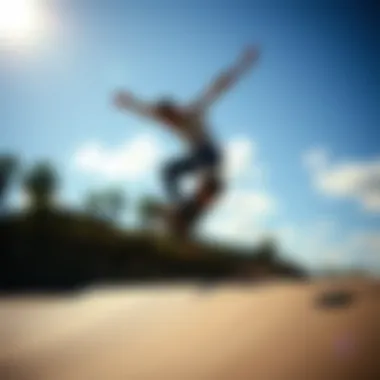
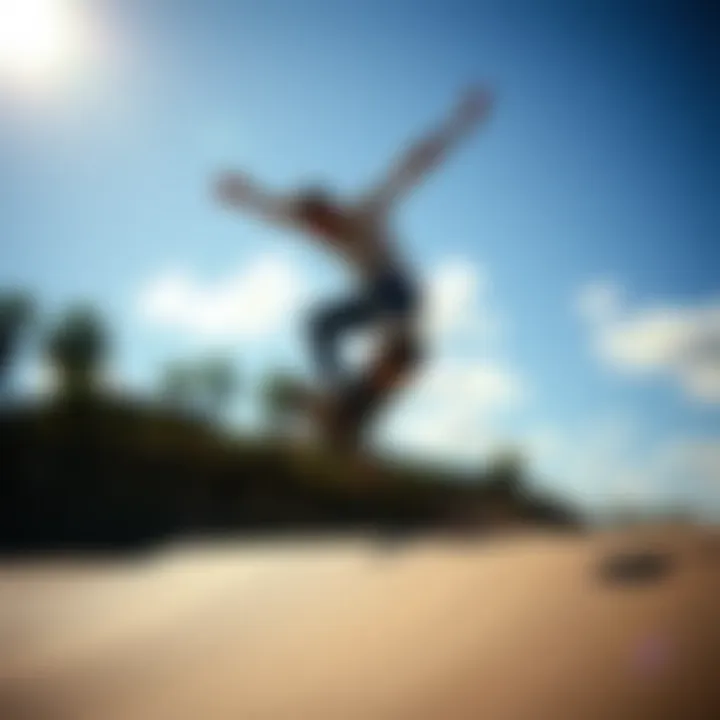
Common Mistakes in the Ollie
When diving into the world of skateboarding, the ollie stands as a cornerstone trick that can pave the way for many advanced maneuvers. However, even skilled riders can stumble upon common pitfalls that may hinder their progress. In this section, we will explore some prevalent mistakes skaters make while attempting to master the ollie. Addressing these issues is crucial not only for improving performance but also for ensuring a smoother learning curve.
Flat Landing
One of the most frequent errors is the flat landing after executing an ollie. When you come down without bending your knees, it can lead to two significant problems: losing balance and potential injuries. A flat landing does not absorb the impact properly, which can wear out your board faster and increase the risk of falling. Instead, practice landing with a slight bend in your knees. This enables you to control your weight better and maintain balance. Think of absorbing the impact like a spring; the flex allows you to roll away cleanly.
"How you land can make or break your trick. A smooth landing tells the world you know your stuff."
Here are few tips to avoid flat landings:
- Practice your knee bend: Stand in place and mimic the landing position. Focus on keeping your knees loose.
- Use a soft surface during practice, if possible, to help build confidence as you work on your form.
- Record yourself: Watching playback can help you spot where you may be going wrong.
Inconsistent Pop
Inconsistent pop is another hurdle that many skaters face. The pop of your tail is what gives your ollie the lift it needs, so if there’s no explosion when you attempt the trick, you are left closer to the ground, making it virtually impossible to catch air. If you feel like your ollies are all over the place, the issue might stem from your foot placement or timing.
To nail the pop each time, try to keep your weight balanced over the tail before you begin the takeoff. Practice the motion of snapping the tail down, followed by dragging your front foot up the board. It’s like two pieces of a puzzle that fit together. With each attempt, strive for a more controlled movement; consistency will follow.
Here’s how you can improve your pop:
- Foot Placement: Experiment with where you place your back foot. Being too far back or too far forward can affect your pop dramatically.
- Repetition: Spend time just popping your board without ollies. This will help strengthen your tail pops and improve your feel for the board.
- Tune Your Timing: Work on coordinating the snapping of the tail with the drag of your foot for an effortless pop.
Neglecting Body Position
Lastly, neglecting body position is a common mistake novice skaters often make. Your body should act as a dynamic unit—everything moves together. If your shoulders aren't in line with your board, your ollie will likely become a disaster. Maintaining a proper stance involves engaging your core and keeping your weight balanced. If you lean too far forward or backward, you're setting yourself up for a funky landing.
For an ideal body position:
- Keep your shoulders in alignment with your board during the ollie to maintain control.
- Engage your core: When your core is active, it helps with stability and balance during the execution of the trick.
- Eyes up: Always keep your eyes focused in front of you, looking where you're headed rather than down at your board.
Tips for Perfecting the Ollie
Perfecting the ollie is not just about repeatedly jumping up and down on your board. It’s a fusion of technique, practice, and mental focus that can elevate your overall skateboarding game. Like honing a craft, it requires dedication and a keen understanding of both the physical and mental aspects of the trick. Grasping these essentials will not only help you execute the ollie with finesse but also expand your capabilities to attempt more advanced tricks later on.
Practice Drills for Beginners
When it comes to mastering the ollie, engaging in specific drills can lay a solid foundation. Here are some practical drills designed to sharpen your skills:
- Stationary Ollies: Start by practicing ollies while standing still. This builds awareness of your foot positioning and the importance of your pop.
- Rolling Ollies: Once you get comfortable, try the ollie while rolling slowly. It simulates the actual setup and helps you understand timing and coordination.
- Obstacle Ollies: Set up small obstacles—like a curb or a stack of books—to jump over. This adds an element of challenge and lets you practice clearing obstacles, boosting your confidence in your jumps.
Utilizing these drills can be like having a roadmap in your journey to grasping the ollie. The more you practice under various conditions, the more natural it will feel, paving the way for a successful transition to more complex maneuvers in skating.
Visualizing the Trick
Visualization plays a crucial role in the learning process. It’s not just about doing; you have to see yourself doing it first. A vivid mental picture of successfully pulling off an ollie can significantly enhance your muscle memory and execution. Here's how to effectively visualize
- Close your Eyes and Imagine: Picture the entire process of the ollie in detail— from your feet positioning to the moment you pop the tail and leap into the air. See it as if you’re actually performing the trick.
- Replay Successful Attempts: If you’ve managed to do a good ollie before, play it back in your mind. Focus on what worked and the feelings associated with the success.
- Incorporate All Senses: Think about what you see, hear, and feel. Imagine the sound of the board popping, the feel of air beneath you, and the rush of landing perfectly.
Visualizing the trick isn't just fluff; it's like programming your brain for success. Each time you picture yourself nailing an ollie, you're sharpening your focus, enhancing your skill set, and preparing yourself for the real deal.
"The more we visualize, the better prepared we are to face challenges."
By embracing these strategies—practicing with purpose and visualizing success—you'll find that you can accelerate your learning curve, bringing you closer to mastering the ollie.
Integrating the Ollie into Advanced Tricks
Mastering the ollie is not just about performing a single trick; it's about laying a foundation for a plethora of advanced maneuvers that can elevate your skateboarding game. As you become familiar with the ollie, integrating it into more complex tricks opens new avenues for creativity and skill expression. Understanding how to incorporate this fundamental move into your skating repertoire can unlock levels of proficiency that may have seemed out of reach.
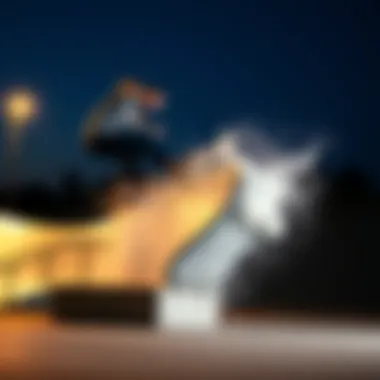
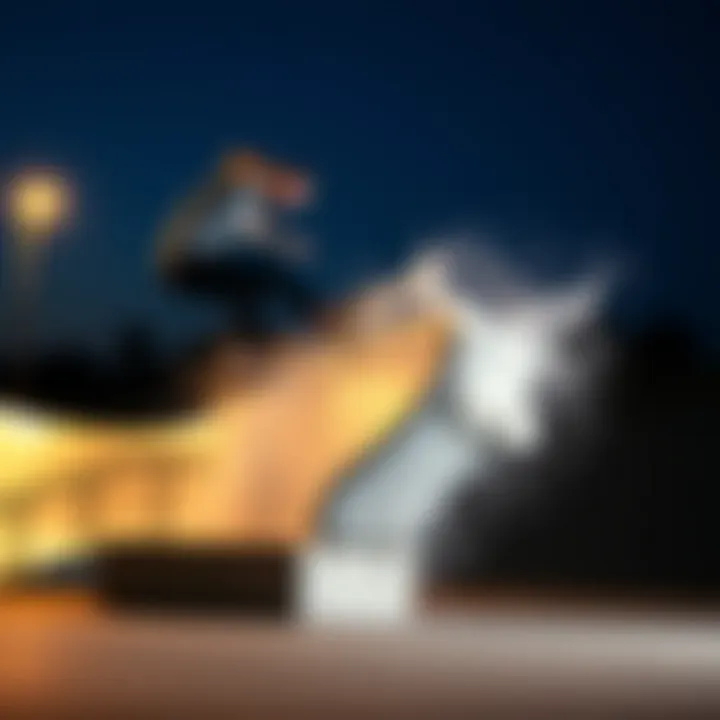
The beauty of the ollie lies in its versatility. Once you've got the basics down pat, you can use it as a stepping stone for a range of variations and combinations. These combinations not only enhance the visual appeal of your skating but also improve your overall agility and foot coordination. This deep dive into ollie variations and how to combine them with other tricks will illuminate pathways to greater mastery.
Ollie Variations
When it comes to ollie variations, creativity is your best friend. There are loads of options that can be downright exhilarating. Here are some notable ones:
- Nollie: This variant consists of popping the tail of the board with the front foot. It's subtle but can significantly change the way your board moves and how you land.
- Fakie Ollie: Executed while riding backward, this type of ollie can add flair to your tricks. It can also be seamlessly transitioned into tricks that require going forward.
- Heel-click Ollie: A twist on the classic ollie where you bring your feet together mid-air. The click adds a distinct visual element, making it appealing.
- 360 Ollie: Here, the board spins 360 degrees beneath the skater, requiring not just skilled basic ollies but also considerable air time.
Taking the time to refine these variations can significantly enhance your playground of tricks. Most importantly, they keep you engaged and challenged, preventing monotony in your practice sessions.
Combining with Other Tricks
Combining the ollie with other tricks is where the magic happens. The ollie's fundamental principles set the stage for a cascade of combinations. As you venture into this territory, consider the following pairings that can enrich both style and technique:
- Ollie to Kickflip: The ollie provides the necessary elevation to initiate a kickflip. The seamless flow between the two generates an impressive effect.
- Ollie to Grinds: Using the ollie to jump onto a rail or ledge leads to numerous grind opportunities. Mastering this transition can drastically widen the array of tricks at your disposal.
- Ollie to Shuvit: The addition of a shuvit following an ollie adds rotations and complexity, generating an appealing pathway for progression in your trick arsenal.
Combining techniques requires timing and finesse. Breaking down the movements into smaller drills can help in mastering how to blend these tricks. Pay attention to body positioning and foot pressure; these are crucial factors that can either make or break a combination.
"Skateboarding is about freedom and creativity. The ollie is your key to unlock both."
Resources for continued learning include Wikipedia on Skateboarding, and various skateboarding forums like Reddit.
Keep pushing forward and integrate what you learn into your skating! You might be surprised at how quickly you progress.
Safety Considerations
When it comes to skateboarding, safety is the name of the game. This is especially true while mastering fundamental tricks like the ollie. Every skater, whether a rookie just starting out or a seasoned rider, should take safety seriously to avoid injuries that could sideline their progress. Understanding the risks involved and using the right protective measures not only enhances your practice experience but also allows skaters to push boundaries with confidence.
Protective Gear Recommendations
In skateboarding, wearing appropriate protective gear is as crucial as mastering the technique itself. Here’s a breakdown of the essential items every skater should consider:
- Helmets: A good helmet can protect your head in case of falls. Look for a helmet that fits well and complies with safety standards. Brands like Pro-Tec and Triple Eight offer reliable options.
- Wrist Guards: To prevent wrist sprains or fractures, particularly during learning phases, wrist guards can provide substantial support and stability. They come in various styles and sizes.
- Knee and Elbow Pads: These pads help absorb the impact from falls. They’re especially important for beginners, who are still finding their balance and might take a few spills.
- Skate Shoes: Proper footwear not only aids in foot placement but also provides cushioning on hard landings. Look for shoes designed specifically for skateboarding, such as those from Vans or Adidas Skateboarding.
Incorporating these safety measures will help improve your confidence and allow for a more enjoyable skating experience. No one wants to be nursing an injury when they could be perfecting their ollie or moving on to other tricks.
Choosing the Right Environment
The environment in which you practice your ollie plays a significant role in how safe and effective your training will be. Here are key factors to consider:
- Flat, Smooth Surfaces: Aim to practice on flat, non-porous surfaces like skate parks with smooth transitions and areas designated for trick practice. Avoid cracked sidewalks or uneven surfaces which can lead to accidents.
- Designated Areas: Explore local skate parks or community centers that feature ramps and flat areas meant for skating. This reduces the risk of collisions with pedestrians or vehicles.
- Weather Considerations: Always check the weather before heading out. Wet or snowy conditions can make surfaces slippery and increase the chances of falls. Opt for a sunny day when the ground is dry and stable.
- Avoid Crowded Spaces: While skating amongst friends can be a blast, practicing in crowded areas can lead to distractions and unintended accidents. Look for quieter times to work on your skills.
"Safety isn’t just a gear thing; it’s about the right mindset and environment. Every session should strive to be as risk-free as possible."
By being mindful of these conditions and making safety a priority, you can focus better on improving your ollie technique and enjoying the ride.
The End and Future Exploration
As we wrap up our exploration of the ollie, it becomes clear that this trick is much more than a simple maneuver; it is a gateway into the broader world of skateboarding innovation and creativity. Understanding the ollie provides skaters with a fundamental base upon which to build more complex tricks. Each part of the ollie—from stance to landing—plays a pivotal role in stability and control.
Moreover, mastering the ollie encourages the skater to analyze their techniques critically. It prompts a deeper comprehension of balance and timing that is crucial for progression. In this journey, one may not only develop technical skills but also cultivate persistence and patience, which are invaluable traits both on and off the board.
Summarizing Key Points
- Foundational Skill: The ollie serves as a cornerstone of many skateboarding tricks, leading into vast possibilities for progression.
- Historical Significance: Knowing the history and evolution of the ollie enriches the appreciation for the culture of skateboarding.
- Technique: Proper technique is essential; understanding each component—timing, body position, and landing—can prevent common mistakes and enhance performance.
- Safety: Emphasizing protective gear and safe practice environments is vital for learning while minimizing risks associated with exploring new tricks.
- Practice Makes Perfect: Continuous practice is crucial. The more one rides, the more natural the movements will become, allowing skaters to innovate and adapt their style.
Encouragement for Continued Practice
It’s important to remember that learning the ollie, like any skill worth mastering, requires patience and determination. Don’t be discouraged by initial failures; even the most skilled skaters had their share of falls and failures. The process of refining your technique can be as rewarding as nailing a trick. Engage with fellow skaters, share tips, and watch each other’s progress. This sense of camaraderie often makes the grind more fun and less lonely.
As you practice, try to set small goals—whether it’s perfecting your pop or achieving a higher lift. Celebrate each victory, no matter how small, as these milestones contribute to your overall growth. Also, don’t forget to document your progress; it can be motivating to look back and see how far you’ve come.
In this journey of mastering the ollie, stay curious. Watch videos, read about advanced techniques, and experiment with your own style. The world of skateboarding is expansive, and the ollie opens doors to an abundance of creativity. Finish each session with the excitement of what’s next, because the joy of skating lies not only in what you can do today but also in what you’ll discover tomorrow.







